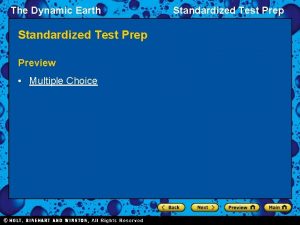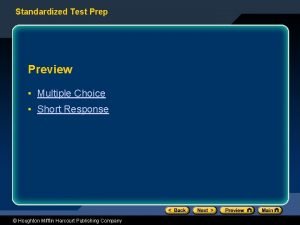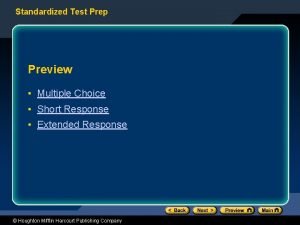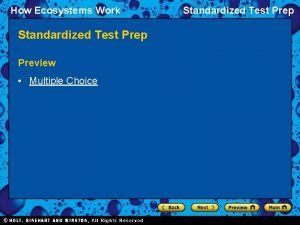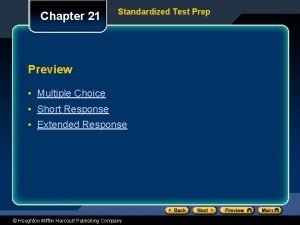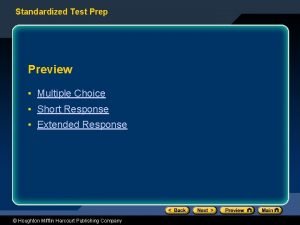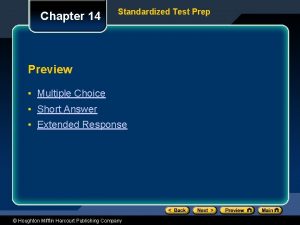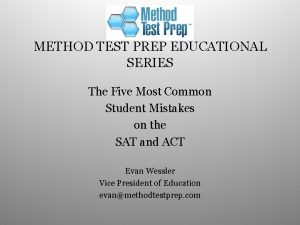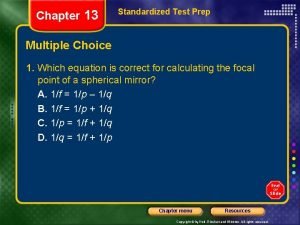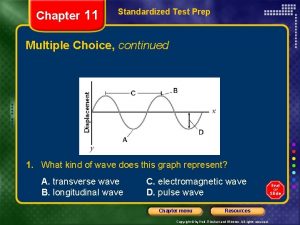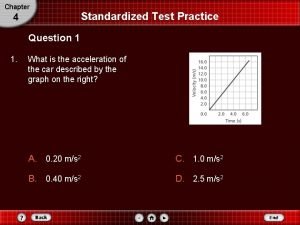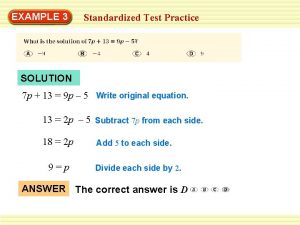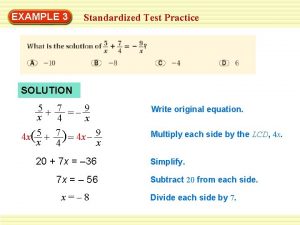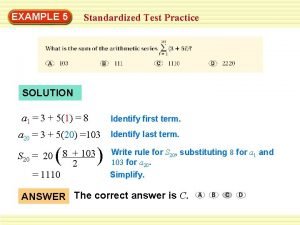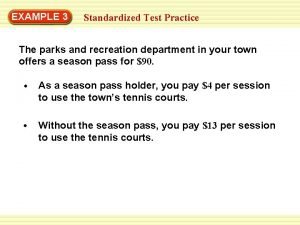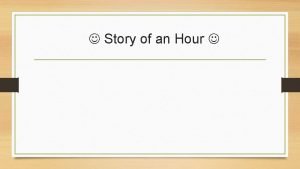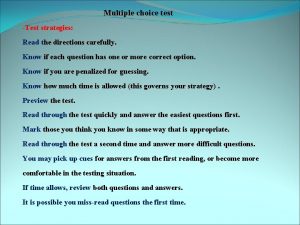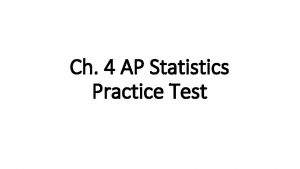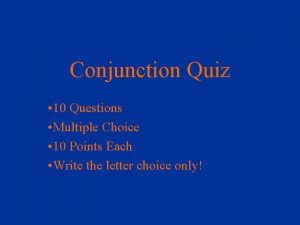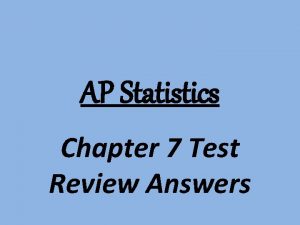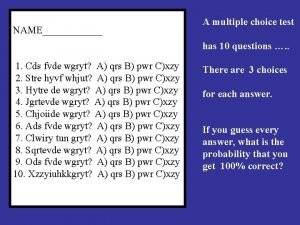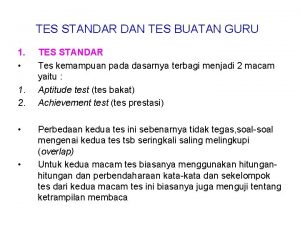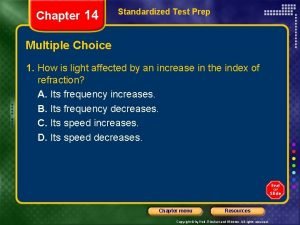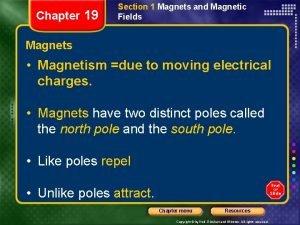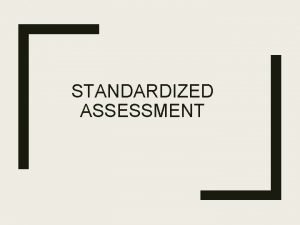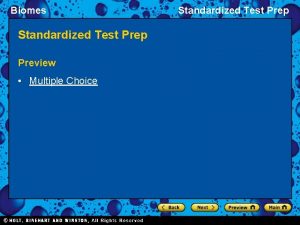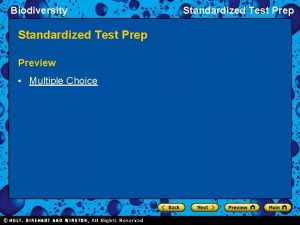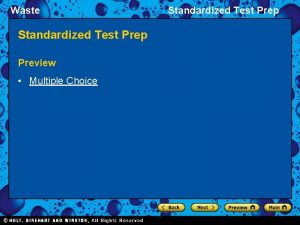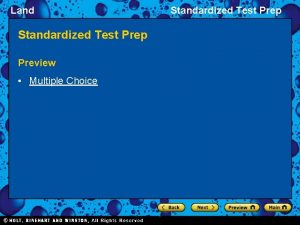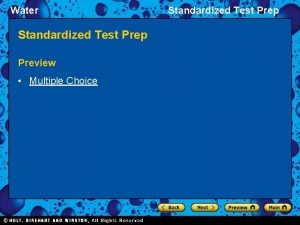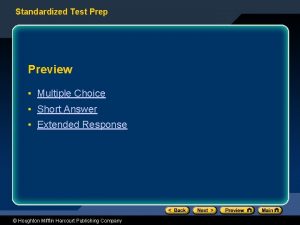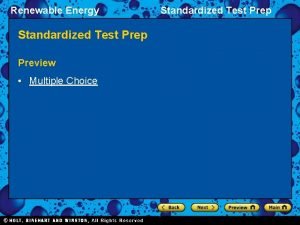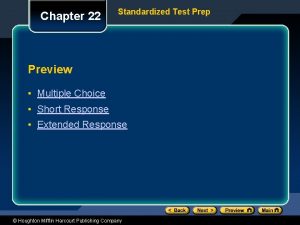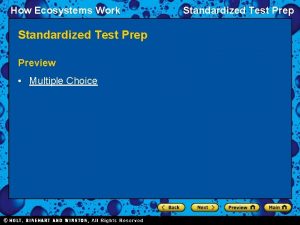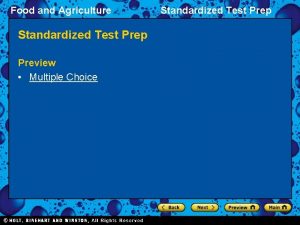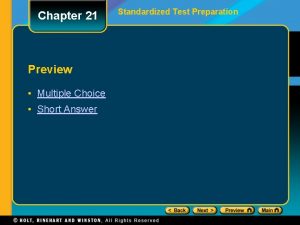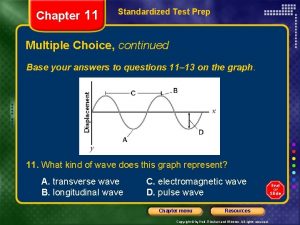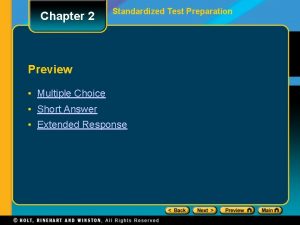Standardized Test Prep Preview Multiple Choice Short Response



































- Slides: 35

Standardized Test Prep Preview • Multiple Choice • Short Response • Extended Response © Houghton Mifflin Harcourt Publishing Company

Standardized Test Prep Multiple Choice Use the passage below to answer questions 1– 2. Two blocks of masses m 1 and m 2 are placed in contact with each other on a smooth, horizontal surface. Block m 1 is on the left of block m 2. A constant horizontal force F to the right is applied to m 1. 1. What is the acceleration of the two blocks? A. C. B. D. © Houghton Mifflin Harcourt Publishing Company

Standardized Test Prep Multiple Choice Use the passage below to answer questions 1– 2. Two blocks of masses m 1 and m 2 are placed in contact with each other on a smooth, horizontal surface. Block m 1 is on the left of block m 2. A constant horizontal force F to the right is applied to m 1. 1. What is the acceleration of the two blocks? A. C. B. D. © Houghton Mifflin Harcourt Publishing Company

Standardized Test Prep Multiple Choice, continued Use the passage below to answer questions 1– 2. Two blocks of masses m 1 and m 2 are placed in contact with each other on a smooth, horizontal surface. Block m 1 is on the left of block m 2. A constant horizontal force F to the right is applied to m 1. 2. What is the horizontal force acting on m 2? F. m 1 a G. m 2 a H. (m 1 + m 2)a J. m 1 m 2 a © Houghton Mifflin Harcourt Publishing Company

Standardized Test Prep Multiple Choice, continued Use the passage below to answer questions 1– 2. Two blocks of masses m 1 and m 2 are placed in contact with each other on a smooth, horizontal surface. Block m 1 is on the left of block m 2. A constant horizontal force F to the right is applied to m 1. 2. What is the horizontal force acting on m 2? F. m 1 a G. m 2 a H. (m 1 + m 2)a J. m 1 m 2 a © Houghton Mifflin Harcourt Publishing Company

Standardized Test Prep Multiple Choice, continued 3. A crate is pulled to the right with a force of 82. 0 N, to the left with a force of 115 N, upward with a force of 565 N, and downward with a force of 236 N. Find the magnitude and direction of the net force on the crate. A. 3. 30 N at 96° counterclockwise from the positive x-axis B. 3. 30 N at 6° counterclockwise from the positive x-axis C. 3. 30 x 102 at 96° counterclockwise from the positive x-axis D. 3. 30 x 102 at 6° counterclockwise from the positive x-axis © Houghton Mifflin Harcourt Publishing Company

Standardized Test Prep Multiple Choice, continued 3. A crate is pulled to the right with a force of 82. 0 N, to the left with a force of 115 N, upward with a force of 565 N, and downward with a force of 236 N. Find the magnitude and direction of the net force on the crate. A. 3. 30 N at 96° counterclockwise from the positive x-axis B. 3. 30 N at 6° counterclockwise from the positive x-axis C. 3. 30 x 102 at 96° counterclockwise from the positive x-axis D. 3. 30 x 102 at 6° counterclockwise from the positive x-axis © Houghton Mifflin Harcourt Publishing Company

Standardized Test Prep Multiple Choice, continued 4. A ball with a mass of m is thrown into the air, as shown in the figure below. What is the force exerted on Earth by the ball? A. mballg directed down B. mballg directed up C. mearthg directed down D. mearthg directed up © Houghton Mifflin Harcourt Publishing Company

Standardized Test Prep Multiple Choice, continued 4. A ball with a mass of m is thrown into the air, as shown in the figure below. What is the force exerted on Earth by the ball? A. mballg directed down B. mballg directed up C. mearthg directed down D. mearthg directed up © Houghton Mifflin Harcourt Publishing Company

Standardized Test Prep Multiple Choice, continued 5. A freight train has a mass of 1. 5 x 107 kg. If the locomotive can exert a constant pull of 7. 5 x 105 N, how long would it take to increase the speed of the train from rest to 85 km/h? (Disregard friction. ) A. 4. 7 x 102 s B. 4. 7 s C. 5. 0 x 10 -2 s D. 5. 0 x 104 s © Houghton Mifflin Harcourt Publishing Company

Standardized Test Prep Multiple Choice, continued 5. A freight train has a mass of 1. 5 x 107 kg. If the locomotive can exert a constant pull of 7. 5 x 105 N, how long would it take to increase the speed of the train from rest to 85 km/h? (Disregard friction. ) A. 4. 7 x 102 s B. 4. 7 s C. 5. 0 x 10 -2 s D. 5. 0 x 104 s © Houghton Mifflin Harcourt Publishing Company

Standardized Test Prep Multiple Choice, continued Use the passage below to answer questions 6– 7. A truck driver slams on the brakes and skids to a stop through a displacement x. 6. If the truck’s mass doubles, find the truck’s skidding distance in terms of x. (Hint: Increasing the mass increases the normal force. ) A. x/4 B. x C. 2 x D. 4 x © Houghton Mifflin Harcourt Publishing Company

Standardized Test Prep Multiple Choice, continued Use the passage below to answer questions 6– 7. A truck driver slams on the brakes and skids to a stop through a displacement x. 6. If the truck’s mass doubles, find the truck’s skidding distance in terms of x. (Hint: Increasing the mass increases the normal force. ) A. x/4 B. x C. 2 x D. 4 x © Houghton Mifflin Harcourt Publishing Company

Standardized Test Prep Multiple Choice, continued Use the passage below to answer questions 6– 7. A truck driver slams on the brakes and skids to a stop through a displacement x. 7. If the truck’s initial velocity were halved, what would be the truck’s skidding distance? A. x/4 B. x C. 2 x D. 4 x © Houghton Mifflin Harcourt Publishing Company

Standardized Test Prep Multiple Choice, continued Use the passage below to answer questions 6– 7. A truck driver slams on the brakes and skids to a stop through a displacement x. 7. If the truck’s initial velocity were halved, what would be the truck’s skidding distance? A. x/4 B. x C. 2 x D. 4 x © Houghton Mifflin Harcourt Publishing Company

Standardized Test Prep Multiple Choice, continued Use the graph at right to answer questions 8– 9. The graph shows the relationship between the applied force and the force of friction. 8. What is the relationship between the forces at point A? F. Fs=Fapplied G. Fk=Fapplied H. Fs<Fapplied I. Fk>Fapplied © Houghton Mifflin Harcourt Publishing Company

Standardized Test Prep Multiple Choice, continued Use the graph at right to answer questions 8– 9. The graph shows the relationship between the applied force and the force of friction. 8. What is the relationship between the forces at point A? F. Fs=Fapplied G. Fk=Fapplied H. Fs<Fapplied I. Fk>Fapplied © Houghton Mifflin Harcourt Publishing Company

Standardized Test Prep Multiple Choice, continued Use the graph at right to answer questions 8– 9. The graph shows the relationship between the applied force and the force of friction. 9. What is the relationship between the forces at point B? A. Fs, max=Fk B. Fk> Fs, max C. Fk>Fapplied D. Fk<Fapplied © Houghton Mifflin Harcourt Publishing Company

Standardized Test Prep Multiple Choice, continued Use the graph at right to answer questions 8– 9. The graph shows the relationship between the applied force and the force of friction. 9. What is the relationship between the forces at point B? A. Fs, max=Fk B. Fk> Fs, max C. Fk>Fapplied D. Fk<Fapplied © Houghton Mifflin Harcourt Publishing Company

Standardized Test Prep Short Response Base your answers to questions 10– 12 on the information below. A 3. 00 kg ball is dropped from rest from the roof of a building 176. 4 m high. While the ball is falling, a horizontal wind exerts a constant force of 12. 0 N on the ball. 10. How long does the ball take to hit the ground? © Houghton Mifflin Harcourt Publishing Company

Standardized Test Prep Short Response Base your answers to questions 10– 12 on the information below. A 3. 00 kg ball is dropped from rest from the roof of a building 176. 4 m high. While the ball is falling, a horizontal wind exerts a constant force of 12. 0 N on the ball. 10. How long does the ball take to hit the ground? Answer: 6. 00 s © Houghton Mifflin Harcourt Publishing Company

Standardized Test Prep Short Response, continued Base your answers to questions 10– 12 on the information below. A 3. 00 kg ball is dropped from rest from the roof of a building 176. 4 m high. While the ball is falling, a horizontal wind exerts a constant force of 12. 0 N on the ball. 11. How far from the building does the ball hit the ground? © Houghton Mifflin Harcourt Publishing Company

Standardized Test Prep Short Response, continued Base your answers to questions 10– 12 on the information below. A 3. 00 kg ball is dropped from rest from the roof of a building 176. 4 m high. While the ball is falling, a horizontal wind exerts a constant force of 12. 0 N on the ball. 11. How far from the building does the ball hit the ground? Answer: 72. 0 m © Houghton Mifflin Harcourt Publishing Company

Standardized Test Prep Short Response, continued Base your answers to questions 10– 12 on the information below. A 3. 00 kg ball is dropped from rest from the roof of a building 176. 4 m high. While the ball is falling, a horizontal wind exerts a constant force of 12. 0 N on the ball. 12. When the ball hits the ground, what is its speed? © Houghton Mifflin Harcourt Publishing Company

Standardized Test Prep Short Response, continued Base your answers to questions 10– 12 on the information below. A 3. 00 kg ball is dropped from rest from the roof of a building 176. 4 m high. While the ball is falling, a horizontal wind exerts a constant force of 12. 0 N on the ball. 12. When the ball hits the ground, what is its speed? Answer: 63. 6 m/s © Houghton Mifflin Harcourt Publishing Company

Standardized Test Prep Short Response, continued Base your answers to questions 13– 15 on the passage. A crate rests on the horizontal bed of a pickup truck. For each situation described below, indicate the motion of the crate relative to the ground, the motion of the crate relative to the truck, and whether the crate will hit the front wall of the truck bed, the back wall, or neither. Disregard friction. 13. Starting at rest, the truck accelerates to the right. © Houghton Mifflin Harcourt Publishing Company

Standardized Test Prep Short Response, continued Base your answers to questions 13– 15 on the passage. A crate rests on the horizontal bed of a pickup truck. For each situation described below, indicate the motion of the crate relative to the ground, the motion of the crate relative to the truck, and whether the crate will hit the front wall of the truck bed, the back wall, or neither. Disregard friction. 13. Starting at rest, the truck accelerates to the right. Answer: at rest, moves to the left, hits back wall © Houghton Mifflin Harcourt Publishing Company

Standardized Test Prep Short Response, continued Base your answers to questions 13– 15 on the passage. A crate rests on the horizontal bed of a pickup truck. For each situation described below, indicate the motion of the crate relative to the ground, the motion of the crate relative to the truck, and whether the crate will hit the front wall of the truck bed, the back wall, or neither. Disregard friction. 14. The crate is at rest relative to the truck while the truck moves with a constant velocity to the right. © Houghton Mifflin Harcourt Publishing Company

Standardized Test Prep Short Response, continued Base your answers to questions 13– 15 on the passage. A crate rests on the horizontal bed of a pickup truck. For each situation described below, indicate the motion of the crate relative to the ground, the motion of the crate relative to the truck, and whether the crate will hit the front wall of the truck bed, the back wall, or neither. Disregard friction. 14. The crate is at rest relative to the truck while the truck moves with a constant velocity to the right. Answer: moves to the right, at rest, neither © Houghton Mifflin Harcourt Publishing Company

Standardized Test Prep Short Response, continued Base your answers to questions 13– 15 on the passage. A crate rests on the horizontal bed of a pickup truck. For each situation described below, indicate the motion of the crate relative to the ground, the motion of the crate relative to the truck, and whether the crate will hit the front wall of the truck bed, the back wall, or neither. Disregard friction. 15. The truck in item 14 slows down. © Houghton Mifflin Harcourt Publishing Company

Standardized Test Prep Short Response, continued Base your answers to questions 13– 15 on the passage. A crate rests on the horizontal bed of a pickup truck. For each situation described below, indicate the motion of the crate relative to the ground, the motion of the crate relative to the truck, and whether the crate will hit the front wall of the truck bed, the back wall, or neither. Disregard friction. 15. The truck in item 14 slows down. Answer: moves to the right, hits front wall © Houghton Mifflin Harcourt Publishing Company

Standardized Test Prep Extended Response 16. A student pulls a rope attached to a 10. 0 kg wooden sled and moves the sled across dry snow. The student pulls with a force of 15. 0 N at an angle of 45. 0º. If mk between the sled and the snow is 0. 040, what is the sled’s acceleration? Show your work. © Houghton Mifflin Harcourt Publishing Company

Standardized Test Prep Extended Response 16. A student pulls a rope attached to a 10. 0 kg wooden sled and moves the sled across dry snow. The student pulls with a force of 15. 0 N at an angle of 45. 0º. If mk between the sled and the snow is 0. 040, what is the sled’s acceleration? Show your work. Answer: 0. 71 m/s 2 © Houghton Mifflin Harcourt Publishing Company

Standardized Test Prep Extended Response, continued 17. You can keep a 3 kg book from dropping by pushing it horizontally against a wall. Draw force diagrams, and identify all the forces involved. How do they combine to result in a zero net force? Will the force you must supply to hold the book up be different for different types of walls? Design a series of experiments to test your answer. Identify exactly which measurements will be necessary and what equipment you will need. © Houghton Mifflin Harcourt Publishing Company

Standardized Test Prep Extended Response, continued 17. You can keep a 3 kg book from dropping by pushing it horizontally against a wall. Draw force diagrams, and identify all the forces involved. How do they combine to result in a zero net force? Will the force you must supply to hold the book up be different for different types of walls? Design a series of experiments to test your answer. Identify exactly which measurements will be necessary and what equipment you will need. Answer: Plans should involve measuring forces such as weight, applied force, normal force, and friction. © Houghton Mifflin Harcourt Publishing Company
 Short short short long long long short short short
Short short short long long long short short short Test prep preview
Test prep preview Test prep preview
Test prep preview Test prep preview
Test prep preview Test prep preview
Test prep preview Test prep preview
Test prep preview Chapter 21 standardized test practice answers
Chapter 21 standardized test practice answers Test prep preview
Test prep preview Test prep preview
Test prep preview Circuit training standardized test prep answers
Circuit training standardized test prep answers Chapter 13 standardized test prep answers
Chapter 13 standardized test prep answers Chapter 11 standardized test practice
Chapter 11 standardized test practice 4 standardized test practice answer key
4 standardized test practice answer key 4-3 standardized test prep answers
4-3 standardized test prep answers 6-3 standardized test prep
6-3 standardized test prep 5-1 standardized test prep
5-1 standardized test prep 3-5 standardized test prep
3-5 standardized test prep Culinary math practice
Culinary math practice Monstrous joy in the story of an hour
Monstrous joy in the story of an hour Directions multiple choice
Directions multiple choice Tonya wanted to estimate the average amount
Tonya wanted to estimate the average amount Polynomials multiple choice test doc
Polynomials multiple choice test doc Hamlet multiple choice test
Hamlet multiple choice test Ap lit practice test multiple-choice
Ap lit practice test multiple-choice Conjunction quiz
Conjunction quiz Ap stats chapter 7 review
Ap stats chapter 7 review Math multiple choice test taking strategies
Math multiple choice test taking strategies Antigone multiple choice test
Antigone multiple choice test Multiple choice questions
Multiple choice questions Good choice or bad choice
Good choice or bad choice Standardized test preparation
Standardized test preparation A rock climber's shoe loosens a rock and her climbing buddy
A rock climber's shoe loosens a rock and her climbing buddy Chapter 14 standardized test practice answers
Chapter 14 standardized test practice answers Chapter 2 standardized test practice answers
Chapter 2 standardized test practice answers Chapter 19 standardized test practice answers
Chapter 19 standardized test practice answers Define standardized test
Define standardized test

